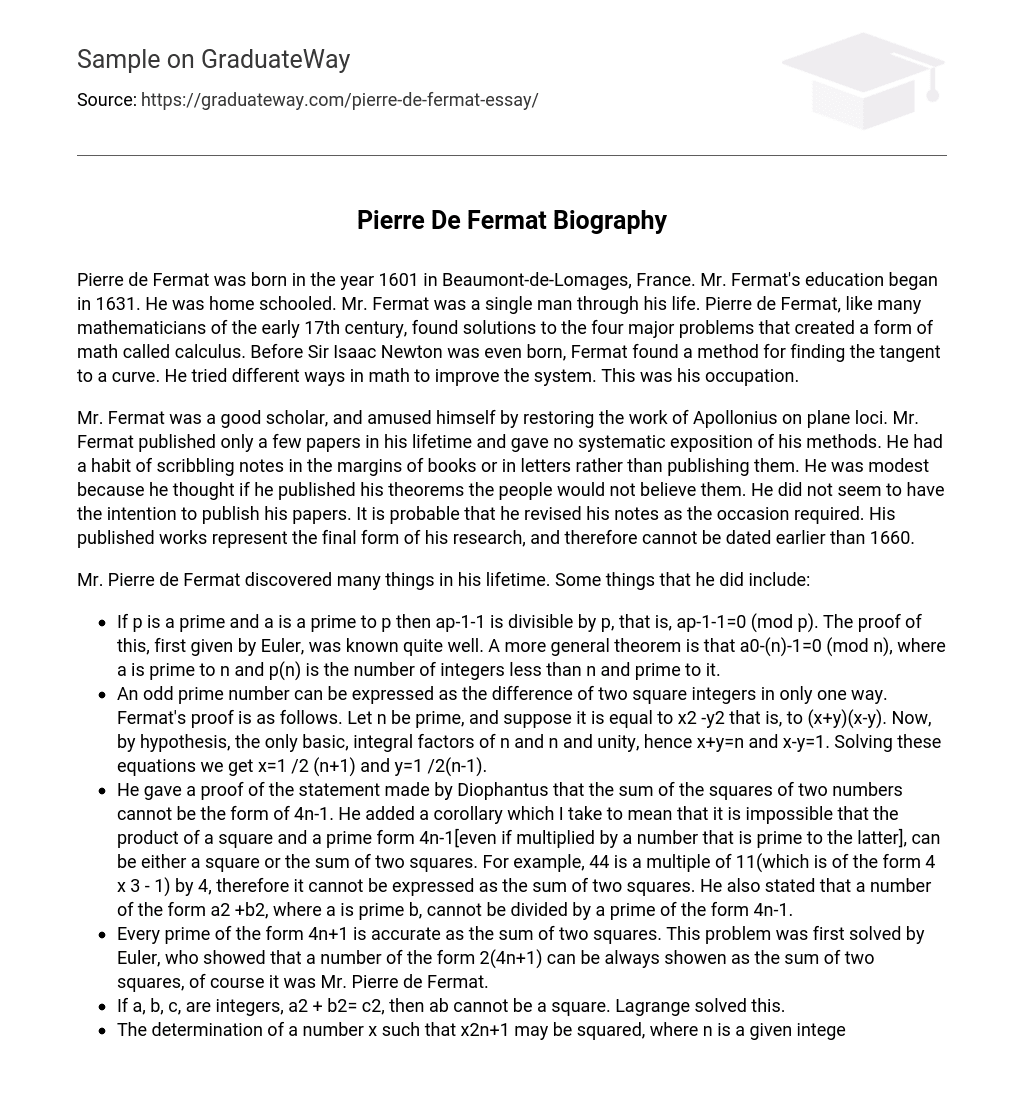Pierre de Fermat, born in 1601 in Beaumont-de-Lomages, France, received his education in 1631 through homeschooling. Throughout his life, Fermat remained single. Like other mathematicians of the early 17th century, he successfully addressed the four significant challenges that contributed to the development of calculus. Even before Sir Isaac Newton’s birth, Fermat devised a technique for determining the tangent to a curve, continually exploring various mathematical approaches to enhance the system. Occupationally, this field became his focus.
Mr. Fermat, a diligent scholar, enjoyed restoring Apollonius’ work on plane loci. However, throughout his life, Mr. Fermat only unveiled a limited number of papers and did not provide a structured explanation of his methods. Instead, he preferred to jot down notes in book margins or letters rather than making them public. This modest behavior stemmed from his belief that if he were to publish his theorems, people would doubt their validity. He seemingly had no intention to officially publish his papers, but rather adapted and refined his notes when necessary. Consequently, his published works reflect the final stage of his research and thus cannot predate 1660.
Mr. Pierre de Fermat made numerous discoveries during his lifetime. Some of his accomplishments include:
- If p is a prime and a is a prime to p then ap-1-1 is divisible by p, that is, ap-1-1=0 (mod p). The proof of this, first given by Euler, was known quite well. A more general theorem is that a0-(n)-1=0 (mod n), where a is prime to n and p(n) is the number of integers less than n and prime to it.
- An odd prime number can be expressed as the difference of two square integers in only one way. Fermat’s proof is as follows. Let n be prime, and suppose it is equal to x2 -y2 that is, to (x+y)(x-y). Now, by hypothesis, the only basic, integral factors of n and n and unity, hence x+y=n and x-y=1. Solving these equations we get x=1 /2 (n+1) and y=1 /2(n-1).
- He gave a proof of the statement made by Diophantus that the sum of the squares of two numbers cannot be the form of 4n-1. He added a corollary which I take to mean that it is impossible that the product of a square and a prime form 4n-1[even if multiplied by a number that is prime to the latter], can be either a square or the sum of two squares. For example, 44 is a multiple of 11(which is of the form 4 x 3 – 1) by 4, therefore it cannot be expressed as the sum of two squares. He also stated that a number of the form a2 +b2, where a is prime b, cannot be divided by a prime of the form 4n-1.
- Every prime of the form 4n+1 is accurate as the sum of two squares. This problem was first solved by Euler, who showed that a number of the form 2(4n+1) can be always showen as the sum of two squares, of course it was Mr. Pierre de Fermat.
- If a, b, c, are integers, a2 + b2= c2, then ab cannot be a square. Lagrange solved this.
- The determination of a number x such that x2n+1 may be squared, where n is a given integer which is not squared. Lagrange gave a solution of this also.
- There is only one integral solution of the equation x2 +4=y3. The required solutions are clearly for the first equation x=5, and for the second equation x=2and x=11. This question was issued as a challenge to the English mathematicians Wallis and Digby.
- No basic values of x, y, z can be found to satisfy the equation xn+yn=zn; if n is an integer greater than 2. This thesis has achieved extraordinary celebrity from the fact that no general demonstration of it has been given, but there is no reason to doubt that this true.
- Fermat also discovered the general theorem that was on the guess that a number can be found into the product of powers of primes in only one way.
In his life, Mr. Fermat engaged in various fascinating activities.
During Mr. Fermat’s life many world events took place. First, Ludolph Van Ceulen, who dedicated his entire life to approximating Pi to 35 decimal places, passed away. There is a website dedicated to him. Then Blaise Pascal, born in 1623 and died in 1662, lived his entire life. In 1642, Sir Isaac Newton was born. In 1648, Marin Mersenne, a French philosopher, mathematician, Jesuit theologian, and scientist, died. Finally, Mr. Pierre de Fermat passed away in 1665.
After his death, some of the most significant results were discovered on loose sheets of paper or written in the margins of the works he had read and annotated. These annotations lack proof, so scholars cannot confirm the validity of Mr. Fermat’s theorems until proof is found.
Bibliography
-
Keyword-
[email protected]
de Fermat -
Keyword- Barnes and
[email protected]
Biography- Pierre de Fermat -
Keyword-
[email protected]
Pierre de Fermat





